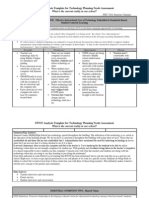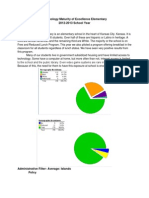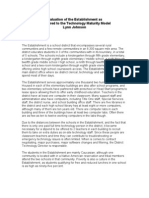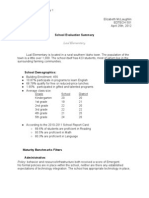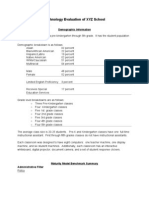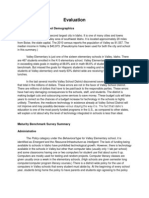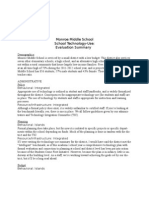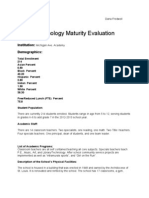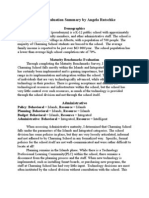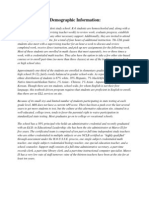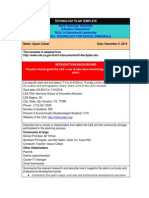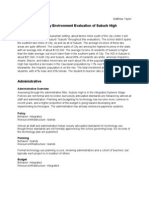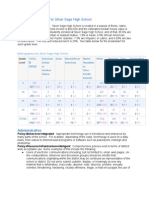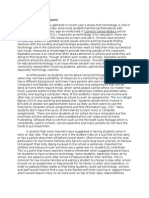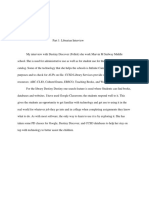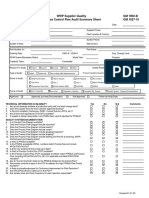Professional Documents
Culture Documents
Administrative: Policy (Behavioral: Intelligent, Resource/infrastructure: Intelligent)
Administrative: Policy (Behavioral: Intelligent, Resource/infrastructure: Intelligent)
Uploaded by
danielmatthewsOriginal Description:
Original Title
Copyright
Available Formats
Share this document
Did you find this document useful?
Is this content inappropriate?
Report this DocumentCopyright:
Available Formats
Administrative: Policy (Behavioral: Intelligent, Resource/infrastructure: Intelligent)
Administrative: Policy (Behavioral: Intelligent, Resource/infrastructure: Intelligent)
Uploaded by
danielmatthewsCopyright:
Available Formats
Summary
This report is based on Overthere Secondary School (OSS) located in Overthere, Georgia, USA. Two weeks were spent contacting information technology experts, administrators, and school-level support experts to gather the information found in this report. The school was rated based on nineteen areas divided into five broad categories of administrative, curricular, support, connectivity, and innovation. The school was rated in each area on a scale from emergent meaning that category lacked support or use to Intelligent meaning it is broadly used across all parts of the school. When all categories were considered, OSS averaged a rating second from the top which is integrated. The reasons for this will follow in the report.
Demographics
Overthere is located in a suburban community outside of Atlanta, GA. It is a bedroom community with most people commuting into the city for work. The county has 7 high schools, with 5 of them located less than 10 miles from each other. Overthere has 1086 students with 70 full-time teachers, a student to teacher ratio of 16:1 (county average is 15:1). Of those 1086 students, 575 are on free or reduced lunch which is about 53%. The ethnicity of the school is about half white, another third hispanic and then black, asian, and other making up about 12%.
School Ratings
Overthere Secondary School was rated on 5 categories and each subcategory was rated from emergent to intelligent. The bottom was emergent, mostly meaning the school did not demonstrate many characteristics from that category. The second level is islands meaning the technology is being used in some areas but remains absent in most areas. The third level is integrated meaning the technology is used in most areas and a regular part of school function. The final level is intelligent, meaning it is an integral part of the school during the teachers and students daily regimen.
Administrative
The administrative subcategories deal with the technology planning and budgeting for the school. What policies are already in place and how involved are those in power in placing technology into the hands of those who need to use it the most. Policy (behavioral: Intelligent, resource/infrastructure: Intelligent).
The school has a great perspective of acceptable use by students and by teachers. All students and teachers are required to sign an acceptable use policy before they are given access to a computer. The school district works very hard limiting sites accessible through a filter while allowing students and teachers access to many resources that can enhance instruction. Youtube has been blocked to students, unless it is youtube education while teachers are able to access Youtube for instructional purposes. They blocked Facebook after their research learned it was taking away from instruction more than adding to it; however, Twitter is allowed by students and teachers and many use it regularly. The key item is that the policies in place allow teachers and students to access the necessary sites and technology to be effective in the classroom, even when classes have vastly different needs. Planning (behavioral: Integrated, resource/infrastructure: Integrated) The school technology plan is rated as integrated. OSS has won a grant from Dell which will allow the school to be outfit with 2 new computer labs (replacing the 2 labs that are currently in operation) and replacing many computers in the library and around the building. It also allows all teachers at the school to get new laptops to replace the ones in use that are currently three years old. Right now the technology plan includes the dates at which many line items like computers, projectors, and printers will be replaced. The school has plans to have the most cost effective technology into as many classrooms as possible. The current plan is written for the next 5 years and what will be replaced and when. Budget (behavioral: Intelligent, resource/infrastructure: Integrated) The current budget at OSS allows the school to make the necessary replacements while allowing extra money for new technology as it becomes available. The last fiscal year, new technology had to be purchased at the end of the year to use up left over budget money. This money was spent purchasing Hypercams (a high definition, camera for scanning documents, taking pictures and video, or even video conferencing) for every classroom that wanted one. OSS currently has a grant with dell that funds technology purchases each year through the summer of 2013. The grant helps keep the budget balanced and helps the school with meet many technology needs. Administrative Information (behavioral: Integrated, resource/infrastructure: Intelligent) This category was rated as intelligent in resources because all of the infrastructure is in place for the school to be almost completely paperless. In fact, most processes are currently paperless. Paperless processes include field trip requests, gradebooks, lesson plans, many tests and quizzes, teacher websites updated with assignments and many more things. Almost all day-to-day activities are paperless and rely on technology to accomplish them. A few things are still not which prevented the school from being intelligent on behavior. Discipline referrals still use carbon copies and paper, and bus request forms as do many required signature forms sent home to students at the
beginning of the year. Teacher absences are documented on paper, and many student forms are in paper format.
Curricular
The curricular subcategories assess how technology is being used in the day-to-day activities in the classroom and around the school. It looks at the technology usage from both the teachers and the students perspectives. Electronic Information (behavioral: Integrated, resource/infrastructure: Integrated) This category was rated as integrated for both behavioral and resource because out of a random twelve teachers interviewed ten of them reported using technology daily in their instruction. In fact, of those reported four said they use web-based tools regularly. The most common use of web tools was Google drive, second was Todays Meet which is a resource for online collaboration within the classroom. Many teachers technology included use of powerpoints, Youtube videos, other multimedia such as music and professional videos streamed online, and interactive quizlets. For resources, the school provides teachers access to many resources online, but the school lacks some such as good video and audio editing software as well as voice recognition software. The school also does not have a lot of video recording equipment, because of the lack in certain areas, many students complete projects in the form of posters or poster boards. Assessment (behavioral: Islands, resource/infrastructure: Islands) The school rated as islands in assessment for both behavioral and resources because most teachers still use technology as a source for projects and frequently in their daily work, but they rarely use it for assessments. Most assessments are still done with a pencil and paper. The school has not provided enough resources to make online assessments a reality for most teachers. There are not enough computers or other sources of technology to have students consistently using them for their assessments. Most teachers use the old paper and pencil method, although some reported the way they use technology on assessments is to have kids bubble in answers and then run it through a Scantron machine. Some are doing web-based quizlets or quizzes through school-provided software, but these are few and far between. Curricular Integration (behavioral: Islands, resource/infrastructure: Integrated) Curricular Integration in the classroom is listed as islands for behavior because virtually all teacher use technology in the classroom, but they use it in the same way they would use a blackboard or an overhead projector. Most do not adjust the way they teach because they have been doing it for a long time and some do not know about the resources that are available to them that could change how they do things. Many technologies are available which is why the school rated as integrated in resources and infrastructure. The entire school has wireless with the opportunity to use things like
smartphones to add to the class. They could use the available technology to really transform instruction because the resources are there, but teachers do not know about it, and some do not want to change. Teacher Use (behavioral: Intelligent, resource/infrastructure: Intelligent) The teacher use areas both rated as intelligent because technology is absolutely necessary to go through the day. In fact, the school would have a hard time running if teachers suddenly were not allowed to use technology. The school district has provided all teachers with laptops to use for instruction and non-curricular activities such as email, teacher evaluation, and other school-related functions. Teachers have the freedom to add or delete programs from the school computers. The school has also provided many resources that are on the school intranet, and not on the Internet so when the internet goes down teachers still have access to important information such as gradebooks, lesson plans, and attendance records for students. All communication is also through the computer, as teachers have the capability to make phone calls using the microphone and speakers on the computer. A few teachers commented that they had a technology need at some point while teaching and the school is very good about getting necessary resources into their hands in a very timely manner. Student Use (behavioral: Islands, resource/infrastructure: Islands) Student use rated as islands for both resource and behavioral. Students do not have many opportunities to use technology as part of the curriculum, in large part because of teacher behavior. Students have good access to technology when they provide the technology piece themselves. Since the whole campus is wireless, students with smartphones and computers of their own can access the web and utilize it anytime. The struggle with the wireless is that the school cannot provide laptops for all students. Students do not have much access regularly to do curriculum related activities. As a result of this, more than half of network access by students is done playing games and non-curricular social media. Select classes use programs such as Minescape and other game based learning methods in the classroom.
Support
The support subcategories look at the involvement of the staff and support staff in the support, training, and technical support aspects of technology. Stakeholder Involvement (behavioral: Islands, resource/infrastructure: Emergent) Stakeholders at OSS are not very involved in the planning and introduction of new or current technologies. Very few people make all of the decisions for the entire school. The administration is in charge of most decisions, and many decisions are even out of the administrators hands because these come down from the technology department at the central office. Things like teachers laptops and computer lab computers as well as infrastructure is completely out of the stakeholders hands. Some things are in
stakeholders hands such as what software to use, but major decisions are made for stakeholders without input. Administrative Support (behavioral: Intelligent, resource/infrastructure: Integrated) Administration gives outstanding support for teachers and rolling out new technologies and giving support for the technology that is there. For that reason this section is rated as intelligent with resources as integrated. Administration gives a technology update at each faculty meeting every two weeks and offers option training that they will lead on a bi-weekly basis. These training sessions are called Techno-Tuesdays and are hosted on Tuesday mornings before school. Administrators are willing to meet individually with teachers who need extra help. They give outstanding support; however, resources are not listed as intelligent because of recent budget cuts that have reduced the number of teacher work days. The school used to host technology training on teacher work days, but this year the school has cut the number of teacher work days to only 7. Two before school starts and three at the end of the year and then only two during the school year. On the two teacher work days only an hour each day is dedicated to technology training. This is the reason the school is integrated instead of intelligent in resource/infrastructure. Training (behavioral: emergent, resource/infrastructure: Islands) Training scored emergent, not because the training offered is poor, but because of a severe lack of teachers who attend the optional training sessions. Most teachers prefer to learn new technology on their own, or just stick with what theyre doing. The attendance at the Techno-Tuesday training sessions have consistently been only five or six teachers. Someone spends time preparing a presentation for only five or six people to attend. Some sessions have even been cancelled due to a lack of interest by teachers. The resources rated as islands because most training ends up being informal between peers and mentors. Teachers collaborate very well with one another, but lack of attendance at formal training sessions makes most training completed informally. Technical/Infrastructure Support (behavioral: Integrated, resource/infrastructure: Intelligent) Technical support earned an integrated rating for behavior because most teachers will try to go to their peers for support before contacting a technical support professional. Every department has what they called a go-to person when they need help on a technical issue. Every teacher was quick to name their go-to person for technology issues. Some departments had more than one person they would go to for help. Some teachers said if their go-to person cant help them they choose to find a way to do without the technology. If the issue is more than the departmental person can handle, then the school has a full-time information technology person who can help with almost any issue. For issues with school computers outside of the typical Monday to Friday 8-4 that central office is open, the school has a 24/7 help line through Dell as part of the
grant from Dell. The computers get free technical support for 5 years from the date stamped on each computer, which will expire in October of 2014 for most of the teacher laptops. The availability of support and a full-time person on each campus gives the school an intelligent rating for resources and infrastructure.
Connectivity
The connectivity subcategories assess the availability of internet and other communication related systems in the school and around campus. Local Area Networking (behavioral: Integrated, resource/infrastructure: Intelligent) Every classroom in the school is set up with a Local Area Network port, and most rooms have two ports for teacher use and an additional six around the room for student use. The network speeds are outstanding with many high speed lines coming into the school. The network is capable of hosting multiple video conferences at the same time without any kind of slow-down due to lack of bandwidth. This is why the school earned intelligent for resources and infrastructure; behaviorally, it rated as integrated because the staff does use area networks for all different parts of instruction. The staff does not use the network for video conferencing very often. It is mainly used for streaming media, research, lesson plans, and lesson delivery. District Area Networking (behavioral: Integrated, resource/infrastructure: Intelligent) Behavior is integrated because many teachers will share resources over the WAN with teachers in other schools in the district. All teachers have access to a quiz software through the teacherpages website. This quiz software has a test bank in it. Teachers anywhere in the district can create quizzes or tests and all of the questions, answers, and quiz settings are saved in a central location so any teacher can see and use that quiz or questions from that quiz. Teachers at different schools will then collaborate using those resources. The entire district is also connected using Microsoft Lync which has video conferencing capabilities between schools in the district. The school district has set up the network district wide with many high speed lines and wireless internet access in every county-owned building. Since all schools are on the same network, a teacher can move from school to school without an interruption in service or the need to learn new login information at the different schools. The wireless access points in every classroom in the school allow students to have ample access to school networks. Internet Access (behavioral: Integrated, resource/infrastructure: Intelligent) The internet is accessed very regularly by students and staff. Some students will spend almost the entire day on their cell phones or iPads connected to the internet. Much student connection time is non-curricular which prevents the school from rating intelligent. The school is intelligent for resources because every building in the school is setup with wireless internet access. Someone can walk from the gym to the other end of
the school and even out into the stadium without ever losing the wireless internet signal. With access points in each classroom there are more than enough access points for all students and staff to be concurrently on the network. Communication Systems (behavioral: Integrated, resource/infrastructure: Intelligent) The only reason the school rated integrated behaviorally is that teachers do not have phone lines in their classrooms. However, teachers have the capability to make phone calls, even to phone lines, from their computers. Although they can make calls, teacher cannot receive calls to their computers unless it is from another computer. Most teachers use email as the main source of communication with parents and other teachers. Some teachers even use Twitter as a way to communicate with students and parents. They will Tweet assignments, upcoming tests, and events occurring in their classrooms regularly to keep students and parents up-to-date on what is happening in class. Students also have access to email through Google. Each student has a gmail account with a domain name through the school system so students are able to turn in assignments paperless through email or in Google drive folders.
Innovation
The innovation subcategories assess both the staffs and the administrations willingness to bring in new technology and train on it. New Technologies (behavioral: Integrated, resource/infrastructure: Integrated) Most staff is very receptive to trying new technology if they can see how it will help students stay engaged in learning. When the first interactive whiteboard appeared in the classroom many teachers requested one. In less than a year the whole school had them and almost all of the teachers were using them, or learning how to use them. The interactive whiteboards are an example of how quickly teachers will incorporate technology if it is useful for engaging students. All classrooms now have interactive whiteboards and most of them have Hypercam document cameras. All rooms have video projectors and all teachers have laptops that are regularly updated with current technologies that are useful in the classroom. The fact that not all teachers use new technology and not all technologies are quickly integrated into the classrooms prevented the school from being rated intelligent in both categories. Comprehensive Technologies (behavioral: Integrated, resource/infrastructure: Integrated) The school rated as integrated in both categories; because, most staff members very readily accept new technology, but most do not utilize technologies such as video conferencing and voice recognition software. The school does not have the advanced software for voice recognition available to teachers, but it has the software available for many advanced techniques such as online collaboration, video conferencing, and game
based learning. The school was very close to rating as intelligent in this category, but voice recognition left them at integrated.
Final Summary
Overall the school would rate out as an integrated school for technology maturity. While the administrative, connectivity, and innovation categories were rated very high there some deficiencies in curricular and support categories. The main issues noted were student connectivity and access to technology for students. Also stakeholder involvement in planning and purchasing of resources could be improved very easily to improve the schools maturity in that area. Overall, Overthere Secondary School has done very well integrating technological resources and involving teachers who are willing to change to try to engage as many students as possible. Out of a possible of 38 ratings, 29 of these ratings were either intelligent or integrated. All of the reasons listed above and the average ratings from the whole thing lead to an overall rating of integrated for the institution.
You might also like
- Educ 5324-Technology PlanDocument7 pagesEduc 5324-Technology Planapi-301350111100% (1)
- Swot Template RevisedDocument15 pagesSwot Template Revisedapi-232628807100% (1)
- Technology Maturity of Excellence Elementary 2012-2013 School Year DemographicsDocument8 pagesTechnology Maturity of Excellence Elementary 2012-2013 School Year Demographicspuppeted85No ratings yet
- Technology Maturity Riverton High School 2012-2013 Academic School Year DemographicsDocument7 pagesTechnology Maturity Riverton High School 2012-2013 Academic School Year DemographicsSarah SchneiderNo ratings yet
- Evaluation of The Establishment As Compared To The Technology Maturity Model Lynn JohnsonDocument8 pagesEvaluation of The Establishment As Compared To The Technology Maturity Model Lynn JohnsonLynnDJJohnsonNo ratings yet
- School Evaluation Summary School Demographics: Behavioral: Integrated StageDocument6 pagesSchool Evaluation Summary School Demographics: Behavioral: Integrated StageMonica MachadoNo ratings yet
- School Evaluation Summary: Laul ElementaryDocument5 pagesSchool Evaluation Summary: Laul ElementaryellimclaughlinNo ratings yet
- Maturity Benchmarks Survey SheetDocument9 pagesMaturity Benchmarks Survey SheetdanielmatthewsNo ratings yet
- School Evaluation Summary: DemographicsDocument9 pagesSchool Evaluation Summary: DemographicsroundyaNo ratings yet
- Maturity Benchmarks Survey SheetDocument4 pagesMaturity Benchmarks Survey SheetamlevangieNo ratings yet
- Evaluation PagliughiS 1Document9 pagesEvaluation PagliughiS 1Jacquelyn HeflinNo ratings yet
- School Environment Evaluation: Maturity Model Benchmark FiltersDocument5 pagesSchool Environment Evaluation: Maturity Model Benchmark FiltersCatherine HolthausNo ratings yet
- BF High School (BFHS) EvaluationDocument9 pagesBF High School (BFHS) EvaluationkathystricklandNo ratings yet
- Maturity Model BenchmarksDocument7 pagesMaturity Model BenchmarksKathryn AverkampNo ratings yet
- Technology Maturity Evaluation Nathan de GrootDocument4 pagesTechnology Maturity Evaluation Nathan de GrootNathan Pete De GrootNo ratings yet
- Demographics: Cow Pie HighDocument6 pagesDemographics: Cow Pie HighAmyEkoMorganNo ratings yet
- Technology Evaluation of XYZ School: Demographic InformationDocument8 pagesTechnology Evaluation of XYZ School: Demographic InformationRonGardinerNo ratings yet
- Evaluation: Valley Elementary School DemographicsDocument5 pagesEvaluation: Valley Elementary School DemographicsangelabaezNo ratings yet
- School Evaluation Summary: AdministrativeDocument7 pagesSchool Evaluation Summary: AdministrativeellimclaughlinNo ratings yet
- Technology Maturity Benchmark Evaluation DemographicsDocument4 pagesTechnology Maturity Benchmark Evaluation DemographicsjoshfizzleNo ratings yet
- Evaluation Yanowsky VDocument5 pagesEvaluation Yanowsky VVirginia Yenter YanowskyNo ratings yet
- Institutional Demographics: Policy - Behavioral: Islands Resource/Infrastructure: IslandsDocument7 pagesInstitutional Demographics: Policy - Behavioral: Islands Resource/Infrastructure: IslandsJason AbateNo ratings yet
- Virtual Success School DemographicsDocument8 pagesVirtual Success School DemographicstysonchaplinNo ratings yet
- Charter School - Greg CorderoDocument7 pagesCharter School - Greg CorderogregcorderoNo ratings yet
- AWebb Tech Use EvalDocument5 pagesAWebb Tech Use EvalAfton Rose ThompsonNo ratings yet
- School Maturity Evaluation: Ronen Cohen "Mountain School" December 10, 2012Document8 pagesSchool Maturity Evaluation: Ronen Cohen "Mountain School" December 10, 2012ronentechNo ratings yet
- Technology Evaluation of ABC Elementary SchoolDocument10 pagesTechnology Evaluation of ABC Elementary SchooltonyagrantNo ratings yet
- Technology Maturity Evaluation: Institution: DemographicsDocument7 pagesTechnology Maturity Evaluation: Institution: DemographicsDana FredwellNo ratings yet
- School Evaluation Summary by Angela RutschkeDocument7 pagesSchool Evaluation Summary by Angela RutschkeAngela Weis RutschkeNo ratings yet
- School Evaluation SummaryDocument4 pagesSchool Evaluation SummaryDessa SchurrNo ratings yet
- Schulz Junior High School Evaluation Summary: Institution DemographicsDocument4 pagesSchulz Junior High School Evaluation Summary: Institution DemographicsRachaelle Larsen-GrimsrudNo ratings yet
- School Evaluation SummaryDocument9 pagesSchool Evaluation SummarychrsitinesimmsNo ratings yet
- Maturity Benchmark SurveyDocument5 pagesMaturity Benchmark Surveyapi-245941312No ratings yet
- School Maturity Benchmarks Evaluation: AdministrativeDocument7 pagesSchool Maturity Benchmarks Evaluation: AdministrativedamonfairchildNo ratings yet
- Evaluation OsweilerRDocument4 pagesEvaluation OsweilerRryanosweilerNo ratings yet
- School Overview & DemographicsDocument8 pagesSchool Overview & Demographicsbrian_j_oneillNo ratings yet
- Technology Maturity Evaluation: Institution: DemographicsDocument8 pagesTechnology Maturity Evaluation: Institution: DemographicsScott ChapmanNo ratings yet
- Maturity Benchmarks Survey SheetDocument6 pagesMaturity Benchmarks Survey SheetRachaelle Larsen-GrimsrudNo ratings yet
- School EvaluationDocument11 pagesSchool EvaluationjamiemenshouseNo ratings yet
- Evaluation SalvatiJDocument6 pagesEvaluation SalvatiJJeffreySalvatiNo ratings yet
- Educ 5321-Technology Plan AcobanDocument7 pagesEduc 5321-Technology Plan Acobanapi-262722724No ratings yet
- School and Student Description: Demographics (Based Upon Enrollment As of August 2012)Document8 pagesSchool and Student Description: Demographics (Based Upon Enrollment As of August 2012)tornduff0903No ratings yet
- Technology Environment Evaluation of Suburb High DemographicsDocument5 pagesTechnology Environment Evaluation of Suburb High DemographicsMatthew TaylorNo ratings yet
- Evaluation MillsC. 1Document4 pagesEvaluation MillsC. 1cmills26No ratings yet
- Evaluation SalvadorPDocument5 pagesEvaluation SalvadorPPhillip SalvadorNo ratings yet
- Administrative Filter: DemographicsDocument4 pagesAdministrative Filter: DemographicsMike ProcykNo ratings yet
- Evaluation SmithTDocument3 pagesEvaluation SmithTTS4WebNo ratings yet
- Brian Mitchell - School Evaluation: DemographicsDocument5 pagesBrian Mitchell - School Evaluation: DemographicsBrian MitchellNo ratings yet
- Andersong SwotDocument11 pagesAndersong Swotapi-203218664No ratings yet
- Misenhimer TechnologyplanDocument7 pagesMisenhimer Technologyplanapi-317247682No ratings yet
- Equitable Access 2Document4 pagesEquitable Access 2api-276793483No ratings yet
- Research Assignment 6 - Technology ProjectDocument7 pagesResearch Assignment 6 - Technology Projectapi-302321792No ratings yet
- Edu 214 Midterm PaperDocument5 pagesEdu 214 Midterm Paperapi-491565788No ratings yet
- Final Project Victor Rivera EDU 623 Dr. KaiserDocument15 pagesFinal Project Victor Rivera EDU 623 Dr. KaiserRivera21No ratings yet
- Evaluation - Ball, J.Document8 pagesEvaluation - Ball, J.Jennifer BallNo ratings yet
- Ncts Tamburro Swot FinalDocument11 pagesNcts Tamburro Swot Finalapi-200214439No ratings yet
- Educ 5324-Technology Plan Template 2 - 3Document6 pagesEduc 5324-Technology Plan Template 2 - 3api-340978568No ratings yet
- School EvaluationDocument7 pagesSchool EvaluationRoss EwingNo ratings yet
- School Environment Evaluation DemographicsDocument6 pagesSchool Environment Evaluation DemographicsAndrea Ball RossNo ratings yet
- My Graduate JourneyDocument15 pagesMy Graduate JourneydanielmatthewsNo ratings yet
- Rationale Paper RoughDocument13 pagesRationale Paper RoughdanielmatthewsNo ratings yet
- Rationale Paper Standards 1-2Document7 pagesRationale Paper Standards 1-2danielmatthewsNo ratings yet
- Maturity Benchmarks Survey SheetDocument9 pagesMaturity Benchmarks Survey SheetdanielmatthewsNo ratings yet
- Report On The West Hall High School Football Programs Summer Workout ProgramDocument12 pagesReport On The West Hall High School Football Programs Summer Workout ProgramdanielmatthewsNo ratings yet
- Cards, Money and Two Hacking Forums: An Analysis of Online Money Laundering SchemesDocument4 pagesCards, Money and Two Hacking Forums: An Analysis of Online Money Laundering SchemesSourav SinghNo ratings yet
- Advocates On Record Exam - CasesDocument5 pagesAdvocates On Record Exam - CasesMidhun Kumar AlluNo ratings yet
- 48 VLE 4421 BF - enDocument54 pages48 VLE 4421 BF - enKirilNo ratings yet
- Literature Reviews: 1: The Impact of Human Resource Practices On Employee Retention in The Telecom SectorDocument20 pagesLiterature Reviews: 1: The Impact of Human Resource Practices On Employee Retention in The Telecom SectorFizza EjazNo ratings yet
- Marketing Plan PerseDocument10 pagesMarketing Plan PerseInsactural BlueNo ratings yet
- PTA Margins PresentationDocument15 pagesPTA Margins PresentationUsman IftikharNo ratings yet
- Chapter Seven: Project Implementation ToolsDocument78 pagesChapter Seven: Project Implementation ToolsGeremew Kefale GobenaNo ratings yet
- 100 Yer Pe Yss 0028Document14 pages100 Yer Pe Yss 0028Janakiraman MalligaNo ratings yet
- Activity Ratio Presentation CompleteDocument14 pagesActivity Ratio Presentation CompleteMohsin Raza100% (1)
- Methanol Atm Above Ground Storage Tank PDFDocument7 pagesMethanol Atm Above Ground Storage Tank PDFJuan Jose SossaNo ratings yet
- 3rd PT FBSDocument1 page3rd PT FBSTitser JeffNo ratings yet
- Repair Manual: C3E150 C4E150 C3E160 C4E160 C3E160L C4E160L C3E180 C4E180 C3E180L C4E180L C3E200 C4E200Document464 pagesRepair Manual: C3E150 C4E150 C3E160 C4E160 C3E160L C4E160L C3E180 C4E180 C3E180L C4E180L C3E200 C4E200alllim88100% (1)
- Faci Asiapacific PresentationDocument20 pagesFaci Asiapacific PresentationDhruvesh SanghviNo ratings yet
- Computational Multiphase Flow ThesisDocument299 pagesComputational Multiphase Flow ThesisDeepak K NambiarNo ratings yet
- R12 T07B24 Ifmi XX XX SDW El 10009Document1 pageR12 T07B24 Ifmi XX XX SDW El 10009Abrar DigitalNo ratings yet
- GP-9 Process Control Plan Audit Summary SheetDocument5 pagesGP-9 Process Control Plan Audit Summary SheetAsifNo ratings yet
- Hawkins 2014 Cap 2Document311 pagesHawkins 2014 Cap 2Luis VélezNo ratings yet
- Data of Cash+jv, Feb+march-13Document138 pagesData of Cash+jv, Feb+march-13abhisheksethi1990No ratings yet
- Land Reforms in India - Bhoodan Movement & Vinoba BhaveDocument23 pagesLand Reforms in India - Bhoodan Movement & Vinoba BhaveNilesh KhadseNo ratings yet
- Mobile Turnkey Housing, Inc. vs. Ceafco, Inc. Case BriefDocument1 pageMobile Turnkey Housing, Inc. vs. Ceafco, Inc. Case BriefKevinNo ratings yet
- Autonomous Soft Robotic Fish Capable of Escape Maneuvers Using Fluidic Elastomer ActuatorsDocument24 pagesAutonomous Soft Robotic Fish Capable of Escape Maneuvers Using Fluidic Elastomer ActuatorsĐỗ ĐạtNo ratings yet
- Real Time Embedded SystemsDocument35 pagesReal Time Embedded SystemsGilles Rubens Badouet100% (6)
- ATC 114 Steel MRF by Deierlein Et Al.Document5 pagesATC 114 Steel MRF by Deierlein Et Al.faisaladeNo ratings yet
- DataDocument62 pagesDataSADCFNo ratings yet
- Supertie: Fiberglass Formtie SystemsDocument58 pagesSupertie: Fiberglass Formtie SystemsAlket DhamiNo ratings yet
- Impact of Training and Development On Employees' Performance and Productivity: A Case Study of PakistanDocument5 pagesImpact of Training and Development On Employees' Performance and Productivity: A Case Study of PakistanTewfic SeidNo ratings yet
- English 1 ST PaDocument9 pagesEnglish 1 ST PaSufia AktharNo ratings yet
- FCE - 322 - FLUID - MECHANICS - LAB - REPORT - 2.1.2 (AutoRecovered)Document13 pagesFCE - 322 - FLUID - MECHANICS - LAB - REPORT - 2.1.2 (AutoRecovered)Ken MutuiNo ratings yet
- AEC 102 Final Theory Notes 21-3-19 - 210826 - 122033Document120 pagesAEC 102 Final Theory Notes 21-3-19 - 210826 - 122033Ajithiyan SivaNo ratings yet
- File System Implementation: Tran, Van HoaiDocument30 pagesFile System Implementation: Tran, Van HoaiHà Quốc LươngNo ratings yet


